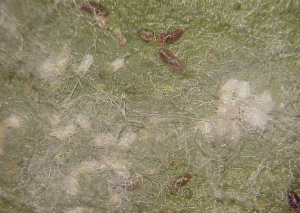
See all posts by this author
What is that ashy looking stuff on my camellia?
Tea scale is the most serious insect pest of flowering camellias. Tea scale also attacks hollies, citrus and the tea plant (Camellia sinensis) as well as a few other plants.

Photo courtesy of Chazz Hesselein, Alabama Cooperative Extension System, Bugwood.org
Tea scale is a small insect that attaches itself to the leaf and sucks plant juices. Adult female tea scales are about 1/10 inch long and are covered with a hard brown cover. The males produce white waxes that cover their bodies. In heavy infestations, these white waxes make the underside of the leaf appear cottony. Affected leaves will develop yellow blotches on the upper surface. Heavily affected plants may be thin and unsightly and have fewer blooms.
Adult scales display a high level of resistance to insecticides, making the initial emergence of crawlers the ideal time for insecticide application. Utilize the previously mentioned data on ‘Tea scale crawler emergence timing for your area’ to determine the appropriate moment to initiate treatment. Ensure that the insecticides thoroughly coat the underside of the leaves during application. In cases of severe infestations, multiple treatments might be necessary.
Trimming heavily affected branches and removing 2 to 4-inch non-flowering branches on main limbs within the plant, which are potential scale hideouts, is advisable. Enhancing air flow and facilitating better pesticide infiltration can be achieved by judiciously thinning the plant.
Treat minor to moderate infestations using oil sprays, which are potent against both crawlers and adult scales. Oil sprays come in two varieties: those suitable for the milder temperatures of spring and autumn, and the highly refined oils applicable throughout the growing period. Adhere to all label guidelines to choose the appropriate oil spray, and ensure comprehensive coverage when utilizing oils, as their effectiveness lies in suffocating the pests.
Beneficial insects such as tiny parasitic wasps, convergent lady beetles, green lacewings, and spiders are vital allies in combating tea scale. Opt for oil sprays over conventional insecticides to conserve these beneficial organisms, and limit spraying to only when absolutely essential.
Be prepared for a control period of 2 to 3 years in case of severe tea scale outbreaks. It’s common for the carcasses of the tea scale to linger on the plant post-mortem. After administering treatment, scrutinize plants meticulously to assess the efficacy of the control measures. Distinguish between living and dead tea scales by noting that the former are moist when pressed, while the latter are dry.
Of course, prevention and treatment for tea scale is included in a Plant Health Care subscription from Arborscapes. (As are myriad other pests and diseases) If you would like to become a part of our Plant Health Care program, reach out to Arborscapes today! Your living landscape will be the envy of the entire neighborhood!
See all posts by this author
